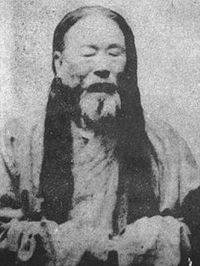Views
Láiguǒ 來果 (1881-1953)
|
| Notable Associates:
|
|
In his 35-year stint as as abbot, Láiguǒ 來果 (1881-1953) was responsible for turning Gāomín Temple 高旻寺 into one of the preeminent centers for Chán practice in the early 20th century.
Contents |
Biography
Láiguǒ first made up his mind to become a monk at the age of 12 suì 歲. More than half a decade later he traveled to Nánpǔtuó shān 南普陀山, but became so despondent at the laxity he saw among the monks there that he resolved to make an offering of his body. He did not go through with it, and eventually he met an ascetic monk. This inspired him, and in Guāngxù 光緒 31 (1905) he went to Mt. Bǎohuá 寶華山 to receive tonsure and ordination. He was tonsured there, but was chased out before he could take ordination. He went to live in a grass hut, where he befriended a wild dog.
In 1907 Láiguǒ heard that ordinations were going to be held at Jiāngtiān Temple 江天寺 at Jīnshān 金山 in Zhènjiāng 鎮江. Before ordination he entered Cháoyáng Cave 潮陽洞 on Máoshān 茅山 in a spiritual quest, and losing track of time, he came out over two months later. He did come out in time to ordain, however. After ordination he stayed to practice Chán 禪 at Jīnshān. He attained enlightenment on the evening of 7/26 Guāngxù 光緒 34 (1908). After this Láiguǒ left and traveled to Mt. Wǔtái 五台山. He decided to go to India to see the sacred sites of Buddhism. On his way, he stopped in his old hometown to see his father.
Over the next three years, Láiguǒ practiced at Gāomín Temple 高旻寺 in Yángzhōu 揚州, at Zhōngnán shān 終南山, and at Tiāntóng Temple 天童寺 in Níngbō 寧波. Finally, he returned to Gāomín Temple in 1915 after the abbot, Yuèláng 月郎 personally came to get him. After his arrival, Yuèláng transmitted the dharma to Láiguǒ and made him abbot of Gāomín Temple, and then died a short while later.In his 35 years as abbot, Láiguǒ emphasized a strict observance of the precepts at the monastery, as well as its identity as an explicitly Chán-oriented temple. He also set about rebuilding, renovating, and adding to the temple structures. This latter work was of such scale that it had not been completed by the start of the Second Sin-Japanese War in 1937.
Láiguǒ retired as abbot in 1950 and died thee years later at the Chóngdé huì 崇德會 in Shànghǎi 上海. His remains were taken back to Gāomín Temple, where a small monument was raised to house them (see picture at left).
Important Works
- 來果禪師開示錄
- 來果禪師語錄
- 來果禪師自行錄
Notable Students
- Miàoshàn 妙善
Notes
References
- Shì Dōngchū 釋東初. Zhōngguó Fójiào jìndài shǐ 中國佛教近代史 (A History of Early Contemporary Chinese Buddhism), in Dōngchū lǎorén quánjí 東初老人全集 (Complete Collection of Old Man Dongchu), vols. 1-2. Taipei: Dongchu, 1974 Pp. 2.795-798.
- Yú Língbō 于凌波, ed. Xiàndài Fójiào rénwù cídiǎn 現代佛教人物辭典 (A Dictionary of Modern Buddhist Persons), 2 vols. Taipei: Foguang, 2004. Pp. 1.537a-540b.

